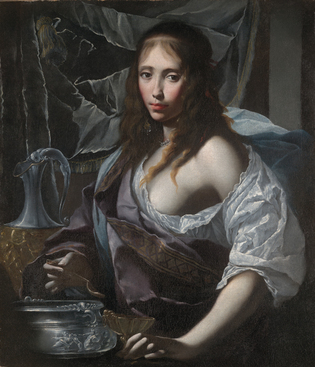 loading
loading
Arts & CultureObject lesson: A masterpiece without a masterWho painted this exceptional seventeenth-century Italian portrait? We don’t know. Laurence Kanter is the Chief Curator and Lionel Goldfrank III Curator of European Art at the Yale University Art Gallery.  Yale University Art GalleryView full imageOne of the seven wonders of the ancient world was the Mausoleum, the imposing tomb erected by Artemisia for her husband, Mausolus, who reigned over much of what is now western Turkey in the fourth century BCE. Even the construction of that architectural marvel could not contain the measure of Artemisia’s love, however. She ordered that Mausolus’s ashes be mixed with perfume and water and she drank them, so that she could be the living tomb in which their bodies would forever be joined. This painting, by an unknown artist, contains all the iconographic elements that tell us the subject is Artemisia. Urns, pitcher, spoon: they were used in numerous other portrayals of the queen, and they tell her unmistakable story. The painting is in all likelihood a historicizing portrait—either of a real person named Artemisia or of a beguiling and exotic beauty intended to flatter a patron whose namesake she was. It was presented as a gift to the Yale University Art Gallery in 1952 with an (incorrect) attribution to the seventeenth-century Florentine painter Cesare Dandini (ca. 1595–1658). The work was identified first as representing Circe, later the Carthaginian noblewoman Sophonisba. While it has been possible to correct the identification of the subject, the identity of the artist remains elusive. Recent conservation has revealed the exceptional quality of the painting, with its striking contrasts of dark and light; its bravura handling of thick, fluid pigment; its evocative simulation of the textures of cloth and of expertly chased precious metal; and its thinly disguised atmosphere both of menace and of enchantment. It is rare in the history of art when a work of such conspicuous quality defies more accurate classification. The painting’s accessories—the basin, ewer, spoon, and cup of silver and gold, the nervously agitated draperies—and its rich, smoldering palette suggest to most scholars an origin in Florence close to the middle of the seventeenth century. But proposals for Naples, Rome, Siena, and Lucca have also been advanced with serious arguments in their defense, as have dates ranging from 1630 to 1660. The next chapter in the history of this painting still waits to be written. In the meantime, you can see it yourself in the newly reinstalled European galleries.
The comment period has expired.
|
|